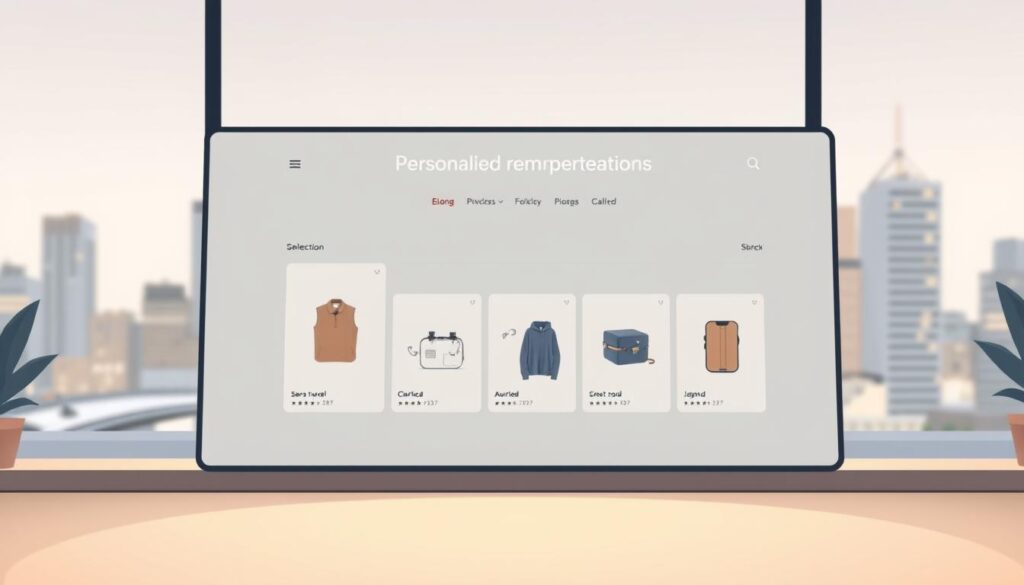81% of business leaders say personal client experiences drive their push to use generative tools, and Gartner predicts adaptive user interfaces will jump from under 5% to 30% by 2026.
This shift changes the way brands talk to people. We’ll show a clear, step-by-step way to use these systems so your brand speaks to each audience member with relevant material, not generic blasts.
Even if you run a small shop, data-driven personalization helps improve customer experience and engagement over time. You’ll learn which experiences to prioritize, what minimal data you need, and how to measure what works.
We keep the plan simple. You get practical strategies for social posts, email, and your site that fit your time and budget. This is a repeatable way to build momentum with small wins that compound.
Key Takeaways
- You can use personalized systems to speak to each user without a big team.
- Start small with clear metrics and a minimal data set.
- Focus on customer experience first, then scale automation.
- Measure engagement by stage of the customer journey.
- Prioritize quick wins that build toward long-term brand growth.
Why Personalized AI content is mission-critical right now
Today, customers expect brands to know them well enough to be useful in the moment. McKinsey finds 71% of consumers expect companies to deliver content personalization, and 67% get frustrated when interactions aren’t tailored.
Meeting expectations matters for growth. Fast-growing businesses generate about 40% more revenue from personalization than slower peers. That shows personalization is a clear marketing and business lever, not just a nice-to-have.
From social feeds to email and on-site modules, users want consistent experiences across channels. Three in five shoppers say they want to use intelligent tools while browsing, so real-time responses lift engagement and conversions.
- Start with the moments: prioritize touchpoints where time and relevance matter most.
- Collect simple signals: preferences, recent interactions, and micro-behaviors give strong insights fast.
- Train a small team: run quick playbooks that turn signals into useful replies and offers.
Do this consistently, and you align personalization efforts with measurable outcomes—higher engagement, lower acquisition costs, and better customer retention.
Personalized AI content versus traditional personalization

Legacy personalization used fixed rules; modern systems adapt as people act. Static segments and manual triggers served marketers for years, but they don’t react to live signals.
What changes with adaptive systems: they update experiences when a user’s behavior or context shifts. That means layouts, modules, and messages can change in real time.
From segments and static rules to adaptive, ai-driven content personalization
Traditional methods rely on curated lists and static profiles. Those approaches scale poorly and often miss short-term intent.
Adaptive systems combine streaming data with learning loops so recommendations and messaging evolve after each interaction. You get faster wins and more relevant experiences across channels.
Gartner’s 2026 outlook: adaptive UIs in 30% of new applications
Gartner predicts adaptive interfaces will grow from under 5% to 30% of new applications by 2026. For companies, that signals a shift in product design and marketing priorities.
What GenAI adds: dynamic generation, continuous learning, and scale
Generative models produce many language and visual variations. They match offers and suggestions to audiences at scale.
- Combine simple rules with learning systems to keep control where needed.
- Use clear goals and the right applications to guide rollout.
- Tie recommendations to measurable outcomes like session depth and conversions.
Start small: pick one touchpoint, measure impact, and expand. With the right approach, you preserve trust while improving relevance for each user.
The business case: revenue, engagement, and efficiency gains

When businesses tie personalization to clear metrics, the financial upside becomes obvious.
Fast growers drive 40% more revenue by matching offers to user intent. McKinsey finds that companies scaling personalization outperform peers by that margin. IBM adds that smarter targeting can halve acquisition costs while lifting conversion and engagement.
Lower acquisition costs and stronger conversions
Better product recommendations reduce wasted ad spend and improve margins. Serve precise offers to qualified audiences and you cut friction at the moment a customer decides.
- Outcomes to track: conversion lift, repeat visits, and loyalty.
- Quick wins: time-sensitive offers, tested recommendation rules, and focused email tests.
- Efficiency: pick tools that let small teams run pilots and scale successful plays.
Estimate ROI by mapping baseline metrics to projected gains over weeks. Share clear dashboards to socialize wins, then de-risk rollout with phased pilots before expanding across channels and audiences.
Build the right data foundation and governance for personalization

A clear data strategy turns scattered interactions into usable customer insights. Start by inventorying what you already collect across platforms. Prioritize behavior, preferences, and recent interactions that drive measurable value.
Define the minimum information you need to personalize responsibly. Fewer fields reduce risk and speed activation. Document how data flows from capture to activation and measurement.
Trust, transparency, and compliance
Follow plain-language consent and privacy notices to meet CCPA and GDPR. Run audits, impact assessments, and role-based access controls. Strong security and retention rules protect customers and your brand.
Operational steps to scale safely
- Connect customer support, social, and site signals for a unified user view.
- Set routines for data hygiene, enrichment, and vendor alignment.
- Build dashboards that show which signals power which outcomes.
“IBM finds that strong data foundations and governance are best practices for scalable personalization.”
When you need a deeper guide on governance, consult data governance for models. Start with must-have signals, prove value, then scale tools and strategies across your teams.
Choose your tool stack: intelligence, content, and analytics

Pick a tool stack that maps directly to the customer journeys you care about. Start with use cases, then select platforms that make those moments better.
Core categories to include
- NLP chatbots and virtual assistants for faster service and simple self-help.
- Recommendation engines for merchandising and related-offer suggestions.
- Dynamic ads and predictive models to target the next best action at scale.
Selection criteria that matter
Weigh integrations, security, and team usability. Check that tools connect to your CRM and analytics platforms without heavy middleware.
- Compare analytics depth so you track outcomes, not just outputs.
- Evaluate model quality, guardrails, and data handling for compliance.
- Prefer cloud-first applications for elastic scale and easier updates.
- Pilot with a narrow slice of content and users, then document SOPs for handoffs.
How to implement Personalized AI content step by step

Start by mapping one clear outcome you want from each campaign—then design steps to reach it. Set measurable goals tied to audience, brand, and campaign outcomes. Keep metrics simple: conversion lift, repeat visits, or CSAT.
Set goals and unite data
Define goals for each audience and tag them to outcomes you can track. Unite data from CRM, web, and email so each user record shows recent interactions and preferences.
Segment, then scale to one-to-one
Start with cohorts. Move toward one-to-one as signals and models mature. Use cohorts to test voice, offers, and language before you generate broader variations.
Generate, deliver, and activate
Produce variations for emails, posts, landing pages, and product recommendations. Use dynamic targeting to serve the right recommendations in real time across social, email, and web.
Close the loop
- Deploy chat support to answer questions and capture feedback.
- Test formats and language to learn what drives action.
- Build weekly routines to review results, refine prompts, and update playbooks.
“Use feedback and performance data to retrain models and sharpen rules.”
Measure, learn, and optimize performance

Measure what matters so your team can learn faster and push smarter updates.
Start by defining your measurement plan. List the KPIs you will track: engagement, conversion rate, CSAT, return visits, and pages per session. Keep definitions consistent so teams compare apples to apples.
What to track and why
Track both numbers and signals. Monitor engagement and conversions to see if changes move the needle. Add CSAT and return visits to capture customer sentiment and loyalty.
A/B testing and analytics workflows
Use Hotjar, Mixpanel, and Optimizely to run controlled experiments and capture user behavior. Allow 3–6 months to judge impact. Short tests reveal immediate reactions; longer windows show sustained performance.
- Define success upfront so everyone knows what to measure.
- Turn raw data into insights by flagging repeatable patterns.
- Collect qualitative feedback to explain why tests won or lost.
- Track efficiency gains to show time saved alongside revenue results.
| Metric | Tool | Action |
|---|---|---|
| Engagement | Mixpanel | Monitor events and funnels weekly |
| Conversion rate | Optimizely | Run A/B tests and roll winners |
| CSAT / Feedback | Hotjar | Collect surveys and session replays |
| Return visits / Pages per session | Analytics | Track cohort retention and page depth |
Share clear reports with stakeholders. Keep a rolling backlog of optimization ideas ranked by impact and effort. Iterate weekly on small fixes and quarterly on larger experiments. Document wins and misses to speed future decisions.
Real-world applications and examples to emulate

Look at live use cases to see how small changes lift engagement and sales fast.
Ecommerce and entertainment: On storefronts, merge browsing and purchase data to power product recommendations that feel helpful, not pushy. Streaming platforms do the same for content suggestions, which keeps users watching longer and increases loyalty.
Sephora’s omnichannel approach shows how to unify in-store and app signals. When you tie loyalty data, appointments, and online behavior together, users get seamless experiences across platforms. That reduces friction and improves repeat interactions.
Case snapshots to copy
- BloomsyBox: A quiz bot drove 60% completion and boosted repeat orders by making interactions playful and short.
- JPMorgan’s IndexGPT: An example of personalization in regulated settings — it shows how tailored guidance can work with guardrails.
- Tripadvisor: Custom itineraries use reviews and behavior to suggest next steps for travelers, useful for any planner or bundle product.
Study these examples and note the core patterns: use recent user behavior, serve the next best step at the right time, and keep the brand voice warm.
| Use case | Key signal | Benefit | How to start |
|---|---|---|---|
| Ecommerce recommendations | Browsing + purchase data | Higher conversion, larger baskets | Start with related-product widgets |
| Streaming suggestions | Watch history | Longer sessions, retention | Test personalized home rows |
| Omnichannel retail | Loyalty + in-store actions | Smoother experiences across platforms | Sync app and POS signals |
| Guided planners | Reviews + preferences | Better trip or bundle planning | Build a simple quiz or itinerary tool |
Translate big-company patterns into lightweight plays your business can run. Use data trails to trigger follow-ups after each user action. Keep marketing creative and human, and let platforms handle scale.
Conclusion
The clearest path forward is to start with a single experiment and expand what works.
Pick one customer moment, run a tight test, and measure a few clear KPIs. Use ai-driven content personalization where it moves the needle, and keep your human voice front and center.
Choose one simple toolset, protect data with plain rules, and document the workflow. That keeps trust high while you scale recommendations and personalize experiences.
Commit to a learning loop: review insights often, refine behavior targeting, and roll winning campaigns into more channels. Do this and your brand will earn loyalty by solving real needs at the right time.
FAQ
How does AI tailor content to each follower and why does it matter?
Machine learning analyzes user behavior, preferences, and interaction history to deliver relevant messages, product recommendations, and experiences. That matters because tailored messaging boosts engagement, increases conversion rates, and builds loyalty by meeting users where they are across social, email, and web channels.
Why is personalized AI content mission-critical right now?
Consumer expectations have shifted—most people expect brands to know their preferences. Meeting those expectations reduces frustration and improves retention. Brands that adopt adaptive personalization see higher engagement and lower acquisition costs, making the approach essential for growth and competitive advantage.
What kinds of data form the foundation for effective personalization?
Use behavioral signals (clicks, time on page), preference data (likes, saved items), interaction history (support chats, purchases), and context signals (device, location, time). Unifying these sources into a clean, governed dataset enables accurate recommendations and targeted campaigns.
How do privacy and compliance fit into personalization?
Trust and transparency are non‑negotiable. Follow laws like CCPA and GDPR, implement clear consent flows, and explain how data is used. Secure storage, access controls, and audit trails help protect customer data and preserve brand reputation.
How is AI-driven personalization different from traditional segmentation?
Traditional approaches rely on static segments and rules. AI enables adaptive personalization—models learn continuously, create one-to-one experiences, and scale dynamic generation across channels. That leads to more relevant messaging and faster optimization.
What tools make up a modern personalization stack?
Core tools include recommendation engines, NLP chatbots, predictive models, dynamic ad platforms, and analytics suites. Choose tools that integrate with your CRM, are secure, match your budget, and are usable by your marketing and analytics teams.
How should small businesses start implementing personalized AI content?
Begin with clear goals tied to audience and campaign outcomes. Collect and unify data, then create segments and move toward one-to-one experiences. Start with simple recommendations and emails, run A/B tests, and add feedback loops to refine models over time.
Which KPIs should we track to measure personalization success?
Track engagement metrics (click-through, time on site), conversion rate, customer satisfaction (CSAT), return visits, pages per session, and revenue uplift from recommendations. Use A/B testing and analytics workflows to iterate and improve results.
Can you give real-world examples of personalization done well?
Ecommerce sites use recommendation engines to increase average order value. Sephora provides unified omnichannel experiences across app and stores. Travel brands like Tripadvisor tailor itineraries based on behavior, improving booking rates and retention.
How do teams keep personalization efforts efficient and scalable?
Automate data pipelines, use modular tools that integrate with existing platforms, and prioritize features that deliver measurable ROI. Cross-functional collaboration between marketing, analytics, and engineering keeps projects on track and ensures continuous improvement.



